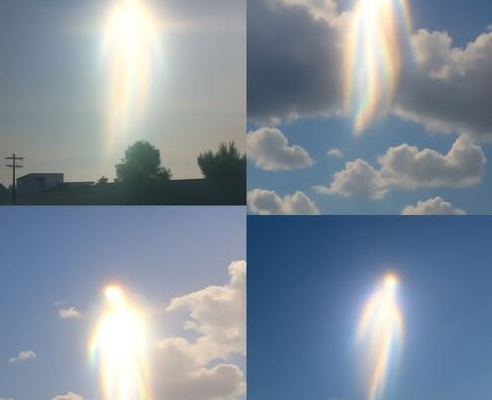
The Mystery of the Red Glow Over the Atlantic Ocean
In the age of satellites, social media, and instant communication, it’s rare for something in our skies to surprise scientists and the public alike. Yet one mysterious phenomenon has recently captured the world’s imagination: a deep red glow spotted over the Atlantic Ocean, illuminating the night sky with an eerie, otherworldly light. Pilots flying over the region first reported the sight, describing it as an “unreal crimson sea” stretching far below them. Photos soon spread online, sparking global speculation about what could cause such an extraordinary sight.
The images show a hauntingly beautiful scene — the vast darkness of the ocean pierced by pools of scarlet light that shimmered like embers in the night. No lightning, no visible land, and no clear explanation. Some viewers immediately suggested natural causes, such as volcanic eruptions beneath the sea or atmospheric refraction from distant lightning storms. Others turned to more imaginative theories — alien activity, secret military experiments, or even portals to another dimension.
But what exactly caused this mysterious glow? Scientists have spent years studying unusual atmospheric and oceanic events, and they have a few grounded explanations that may demystify the spectacle — though the truth remains just as fascinating as the mystery itself.
The First Sightings
The red glow first gained attention when commercial airline pilots captured photographs while crossing the Atlantic at cruising altitude. The pilots, who were flying overnight routes between Europe and North America, reported seeing a wide expanse of deep red light below the clouds, with no visible thunderstorms or lightning nearby. The glow was so intense that it reflected off the undersides of the aircraft and clouds, creating an unsettling sense of flying over a fiery ocean.
When the images began circulating online, scientists, meteorologists, and aviation experts started investigating. The first question: was it even real? As it turned out, the pilots’ photos were genuine and unaltered. That immediately ruled out internet hoaxes or digital manipulation — meaning the light had to have a physical source somewhere below.
Possible Explanation 1: Deep-Sea Fishing Vessels
One of the most widely accepted explanations among experts points to powerful LED lights used by commercial fishing fleets. These vessels, often spread across remote parts of the ocean, use massive arrays of red or orange lights to attract squid and other sea creatures to the surface at night.
Fishing operations like these have become increasingly visible from space in recent years, thanks to the intensity of their lighting systems. Satellite imagery from NASA and the National Oceanic and Atmospheric Administration (NOAA) has revealed enormous zones of artificial light far out at sea — sometimes appearing as floating cities in the middle of nowhere.
In this case, the red hue could have come from a cluster of such vessels working in unison. Because of atmospheric scattering and cloud reflection, their lights might appear as a broad red glow from above, especially when viewed from an airplane at high altitude.
Though this explanation may seem mundane, it’s scientifically consistent — and eerily beautiful in its own right. The thought of a vast flotilla of ships illuminating the dark Atlantic with crimson lights gives a poetic quality to what might otherwise be seen as industrial activity.
Possible Explanation 2: Bioluminescent Phenomena
Another possibility raised by oceanographers is bioluminescence — the natural glow produced by living organisms in the sea. While bioluminescent light is typically blue or green, some species of algae and microorganisms can emit reddish hues under certain chemical or environmental conditions.
These events, while rare, can occur on a massive scale, forming “red tides” that glow faintly at night when disturbed by waves or movement. However, scientists note that it’s unlikely a bioluminescent event alone would produce a glow visible from such high altitudes, especially given the deep, intense color captured in the photos. Still, it’s possible that a combination of natural light and human activity could have contributed to the spectacle.
Possible Explanation 3: Atmospheric and Optical Effects
Some atmospheric scientists have proposed that the glow may have been intensified by particular conditions in the air above the ocean. Particles of moisture or dust can amplify and scatter light in unusual ways, especially when combined with the curvature of the Earth and the reflective properties of clouds.
In this scenario, the fishing vessel lights or even distant lightning could have been refracted and magnified by layers of thin cloud, spreading the light over a much wider area than usual. This might explain why the red glow appeared diffuse and radiant rather than pinpointed.
The Human Fascination with the Unknown
What makes this story so captivating isn’t just the glow itself, but what it reveals about human curiosity. Even in a world saturated with technology, there are still moments that remind us how much mystery remains on our own planet. For a few days, the images of that crimson ocean rekindled something primal — the same wonder that once drove sailors to write about ghost ships, phantom lights, and sea monsters lurking beneath the waves.
The phenomenon also underscores how deeply our imaginations are tied to the natural world. The red glow was unsettling because it disrupted our expectations — the night sky was supposed to be black, the ocean dark and silent. Seeing it illuminated in blood-red light evoked both awe and fear, feelings that have inspired myths for centuries.
The Scientific Verdict
After studying satellite data, maritime activity records, and atmospheric reports from the night of the event, researchers concluded that the most likely explanation was indeed large-scale deep-sea fishing operations using high-powered red LED lights. While this may sound anticlimactic, it’s still remarkable that human technology has reached a point where its glow can be seen hundreds of miles away, mistaken for a celestial mystery.
The phenomenon also raises environmental concerns. The use of such intense artificial lighting in marine environments can disrupt ecosystems, confuse migratory species, and even alter the behavior of fish and plankton. Scientists are beginning to study how widespread light pollution in the ocean might affect biodiversity — a reminder that human activity can shape the natural world in ways we barely understand.
The Enduring Mystery
Even with a scientific explanation, the images of the red glow continue to captivate. There’s something hauntingly beautiful about them — a reminder of the thin line between the known and the unknown. They remind us that the Earth, for all our exploration and technology, still holds secrets that can astonish us.
The pilots who first saw it said it was like “flying over the gates of hell.” Scientists say it was probably fishing lights reflected through clouds. But perhaps both are true in a way — it was a glimpse of the world’s fiery beauty, born from a mix of nature, industry, and imagination.
The mystery of the red glow over the Atlantic may now be explained, but its magic endures. It shows how wonder can survive even in the most ordinary of circumstances — a humbling reminder that the planet beneath our wings is still full of surprises, glowing quietly in the night.

